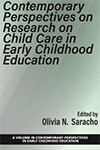
Contemporary Perspectives on Research on Child Care in Early Childhood Education
Edited by:
Olivia Saracho, University of Maryland
A volume in the series: Contemporary Perspectives in Early Childhood Education. Editor(s): Olivia Saracho, University of Maryland.
Published 2021
Child care environments have received extensive research attention by those interested in understanding how participating in nonparental child care might influence the children's development and learning. Throughout the United States (US Census Bureau, 2011) and Europe (Organization for Economic Co-operation and Development, 2006) a large number of young children are cared for outside of the home by non-parental adults. Young children’s nonparental care is commonly referred to as "child care,” and is provided to children whose ages range from birth to 12 years of age. The provision of child care services has become an increasingly important part of early childhood education. In fact, the United Nations Children's Fund (2019) states that a large majority of children worldwide spend at least some of their week in child care, such arrangements include center care, family child care, in-home child care, relative child care, and supplemental child care. Child care researchers have been conducting studies to understand how participating in nonparental child care might influence the children's development and learning outcomes. There are more than enough child care studies to make numerous major inferences. For example, research outcomes show that child care quality seems to be more influential than either the kind of child care or age of admission in determining the children’s development and learning. The adults’ child care affects the quality in child care. In the environment adults who are caring for the children have the opportunity to effectively assume both nurturing and instructional roles to help young children cultivate their social and cognitive abilities. The teachers’ effectiveness is related to their individual characteristics, such as formal education, specialized training, and the classroom environment. However, the majority of the studies show that both family and quality of child care have the most significant effects on the children’s development and learning. Therefore, the concept of child care has heavily influenced modern views. Researchers, scholars, and educators are beginning to understand the current foundations based on theoretical frameworks that contribute to the purposes of the child care in the United States and Europe. The contents of the child care volume reflect the major shifts in the views of these early childhood researchers, scholars, and educators in relation to research outcomes on child care, its historical roots, the role of child care in early childhood education, and its relationship to theory, research, and practice.
CONTENTS
PART I: HISTORICAL FOUNDATIONS AND CHALLENGES OF CHILD CARE. Research and Issues on Child Care, Olivia N. Saracho. The History of Child Care, Olivia N. Saracho. Challenges in Child Care, Olivia N. Saracho. PART II: STRUCTURAL AND PROCESS QUALITY IN CHILD CARE. Exploring the Possibilities of the Environment and Universal Design in Realizing Aspects of Structural and Process Quality in Early Childhood Education and Creating Spaces where Diversity is the Norm, Emer Ring and Lisha O’Sullivan. Early Childhood Professionals’ Psychological Well-Being, Lieny Jeon, Eun Hye Hur, Katherine Ardeleanu, Tonya W. Satchell, and Christopher R. Swanson. The Language Environment of Infant Child Care: Issues of Quantity, Quality, Participation and Context, Sheila Degotardi. PART III: THE ECOCULTURE OF CHILD CARE. Parental Decision Making About Non-Parental Child Care, Katherine K. Rose. Crossing Borders and Circles: Theorizing the Ecoculture of Family Child Care to Inform Supports for Caregiving Quality, Rebecca Anne Swartz and Angela R. Wiley. PART IV: CONCLUSION. Insights and Future Research Directions on Child Care, Olivia N. Saracho. About the Contributors.
-
Paperback978-1-64802-462-7
Web price: $45.04 (Reg. 52.99)
-
Hardcover978-1-64802-463-4
Web price: $80.74 (Reg. 94.99)
- eBook978-1-64802-464-1

- FAM000000 - FAMILY & RELATIONSHIPS: General
- SOC026010 - SOCIAL SCIENCE: SOCIOLOGY: Marriage & Family
- EDU023000 - EDUCATION: Preschool & Kindergarten
-
 Contemporary Perspectives on Research in Assessment and Evaluation in Early Childhood Education
Contemporary Perspectives on Research in Assessment and Evaluation in Early Childhood Education
-
 Contemporary Perspectives on Research in Motivation in Early Childhood Education
Contemporary Perspectives on Research in Motivation in Early Childhood Education
-
 Contemporary Perspectives on Research on Bullying and Victimization in Early Childhood Education
Contemporary Perspectives on Research on Bullying and Victimization in Early Childhood Education
-
 Contemporary Perspectives on Research on Child Development Laboratory Schools in Early Childhood Education
Contemporary Perspectives on Research on Child Development Laboratory Schools in Early Childhood Education
-
 Contemporary Perspectives on Research on Coronavirus Disease 2019 (COVID-19) in Early Childhood Education
Contemporary Perspectives on Research on Coronavirus Disease 2019 (COVID-19) in Early Childhood Education
-
 Contemporary Perspectives on Research on Immigration in Early Childhood Education
Contemporary Perspectives on Research on Immigration in Early Childhood Education
-
 Handbook of Research Methods in Early Childhood Education - Volume 2
Review of Research Methodologies
Handbook of Research Methods in Early Childhood Education - Volume 2
Review of Research Methodologies

